Events & Promotions
|
|

GMAT Club Daily Prep
Thank you for using the timer - this advanced tool can estimate your performance and suggest more practice questions. We have subscribed you to Daily Prep Questions via email.
Customized
for You
Track
Your Progress
Practice
Pays
Not interested in getting valuable practice questions and articles delivered to your email? No problem, unsubscribe here.
- Nov 20
07:30 AM PST
-08:30 AM PST
Learn what truly sets the UC Riverside MBA apart and how it helps in your professional growth - Nov 22
11:00 AM IST
-01:00 PM IST
Do RC/MSR passages scare you? e-GMAT is conducting a masterclass to help you learn – Learn effective reading strategies Tackle difficult RC & MSR with confidence Excel in timed test environment - Nov 23
11:00 AM IST
-01:00 PM IST
Attend this free GMAT Algebra Webinar and learn how to master the most challenging Inequalities and Absolute Value problems with ease. - Nov 25
10:00 AM EST
-11:00 AM EST
Prefer video-based learning? The Target Test Prep OnDemand course is a one-of-a-kind video masterclass featuring 400 hours of lecture-style teaching by Scott Woodbury-Stewart, founder of Target Test Prep and one of the most accomplished GMAT instructors.
Kudos
Bookmarks
"I've been stuck at verbal for weeks now. My CR score won't budge past the 70th percentile." [/b]This message from a frustrated student mirrors what I've heard hundreds of times. That critical barrier between good and exceptional CR performance seems impenetrable for many GMAT aspirants.
The critical thing that most of us are unaware of is - the difference between the 70th and 90th percentile in Critical Reasoning isn't about knowledge—it's about execution. Having helped over 300 students break through this exact plateau, I can confidently state that if you've reached the 70th percentile, you already possess what it takes to reach the 90th.
This distinction isn't merely academic—the jump from 70th to 90th percentile in verbal sections can make a significant difference in your overall GMAT score. That's often the difference between a 645 and a 705, potentially transforming your application from borderline to competitive at top business schools.
In this article, I'll reveal the systematic approach that has consistently helped students make this leap, without requiring endless practice or magical new techniques. You'll learn precisely how to identify what's holding you back and implement targeted strategies that yield measurable results.
Understanding the 70th Percentile Position?
What does it actually mean to be at the 70th percentile in Critical Reasoning? Many test-takers at this level don't fully understand their position—they just know they're not where they want to be.
If you're consistently scoring around the 70th percentile in CR, you have a solid foundation. You have a solid grasp of core CR concepts across most question types. You follow a structured process when approaching questions. You can identify argument components and understand basic logical relationships.
In other words, the challenge isn't your knowledge base; it's the specific weaknesses or bad habits that prevent you from consistently applying this knowledge to the most challenging questions.
These weaknesses often manifest in various ways. You might notice inconsistent performance on difficult questions, or find that time pressure particularly affects your accuracy on certain question types. Perhaps you frequently end up confused between two answer choices, or struggle to adapt when questions become more nuanced.
What makes the 70th percentile position particularly frustrating is that you're likely getting most straightforward and medium-difficulty questions correct but struggling with consistency on the hardest ones. This pattern is exactly what prevents the jump to 90th percentile performance.
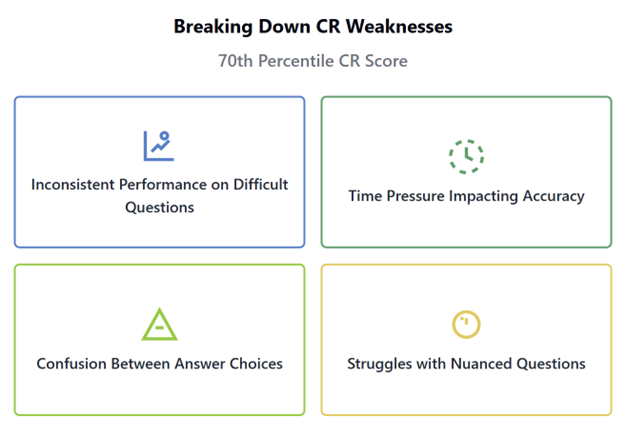
Understanding this position is crucial because it helps you recognize that your improvement strategy needs to be precise and targeted. You don't need to relearn the basics—you need to refine your approach for those specific situations where your performance breaks down.
Creating Your Improvement Plan for Widespread Weaknesses
Before you can break through to the 90th percentile, you need to accurately diagnose what's holding you back. At e-GMAT, we divide Critical Reasoning into 4 distinct blocks to help pinpoint exactly where students struggle.
Block 1 - Inference
Block 2 - Boldface
Block 3 - Assumption, Weaken, Strengthen, and Evaluate
Block 4 - Paradox, Logically Completes and Misc.
There are two primary categories of weaknesses that typically affect students at the 70th percentile:

What are these, and how do you determine which category applies to you? The answer lies in your performance data.
Start by analyzing your accuracy across different question types and difficulty levels. Look specifically at your performance on difficult questions in each CR block.
Widespread application weaknesses:
These affect your performance across all CR question types. If your accuracy is consistently lower on difficult questions, regardless of the question type, you likely have an application issue that stems from either process execution or underlying habits.
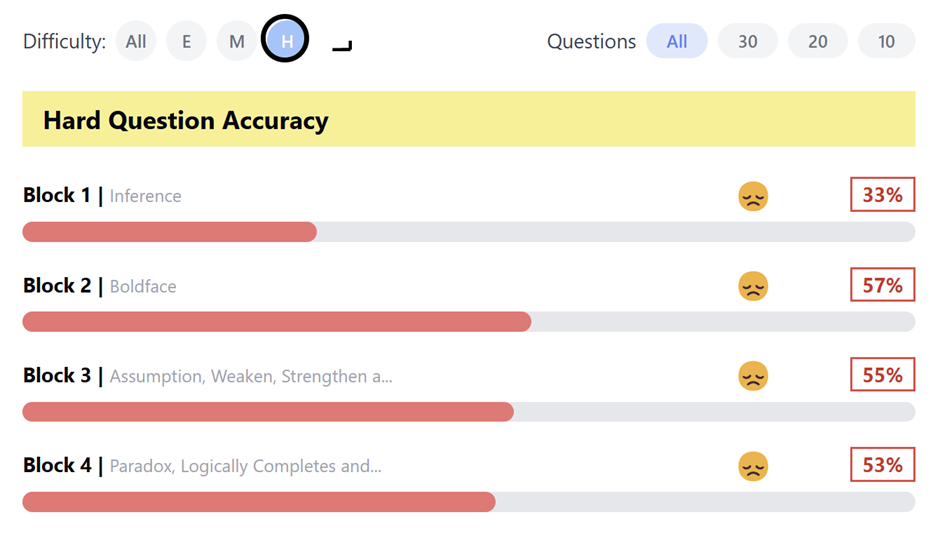
In this image, we can see that across the blocks, the accuracy is below 60%, so it needs improvement across the blocks.
Here you'll often notice that your process breaks down at the same point across different question types, which boils down to bad habits – maybe you are not visualizing the argument well or you are rushing through the answer choice analysis.
Specific weaknesses in particular blocks:
In this case, you might perform well in most areas but struggle significantly with specific question types (such as Inference or Boldface questions). Your accuracy data would show a clear discrepancy between different CR blocks.

In this image, we can see that while the accuracy for Blocks 2 and 3 is great (above 70%), the accuracy for Blocks 1 and 2 is below 50% - so we need to improve the accuracy for Blocks 1 & 4 and maintain the accuracy in Blocks 2 & 3.
For specific weaknesses, you'll see that certain question types consistently trigger the same errors.
Taking the time to perform this detailed diagnosis is crucial. Without it, you risk spending dozens of hours practicing without addressing the real issues holding you back.
Creating Your Improvement Plan for Widespread Weaknesses:
If your diagnosis reveals that you have widespread application weaknesses across all CR question types, your first step is to identify the specific habits or behaviors causing this pattern.
Start by examining your error log data. Look for questions where you were confident in your answer but still got it wrong. These moments reveal the most about your process weaknesses. When reviewing these questions, ask yourself:
Once you've identified your specific weakness, your improvement plan should focus on reinforcing the correct behaviors through deliberate practice. This isn't about solving more questions—it's about solving questions differently.
Create sets of 7-10 hard questions and do focused practice to fix this particular step.
Sample Plan:
Here is a sample plan used by one of our students that helped them improve to the 90th percentile:
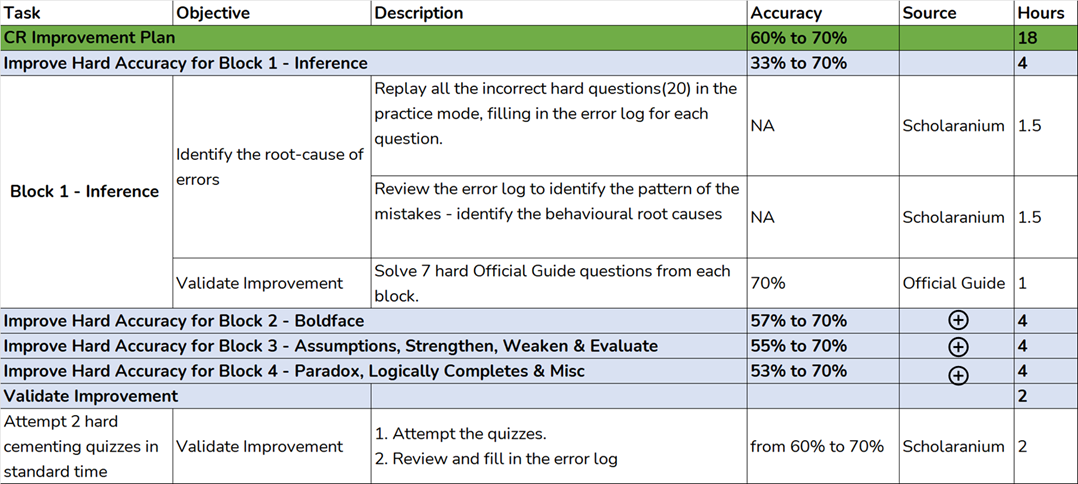
For detailed plan click here - https://www.dropbox.com/scl/fi/46irjtd0jn5fkkxodizr6/CR-Improvement-Plan-Block-1-2_e-GMAT.xlsx?rlkey=61yoh6fcveil2oucrbyknvmwu&st=nzcqvx42&dl=0
Results:
After following the plan, we can see that the hard accuracy across all blocks improved to 70 %+:
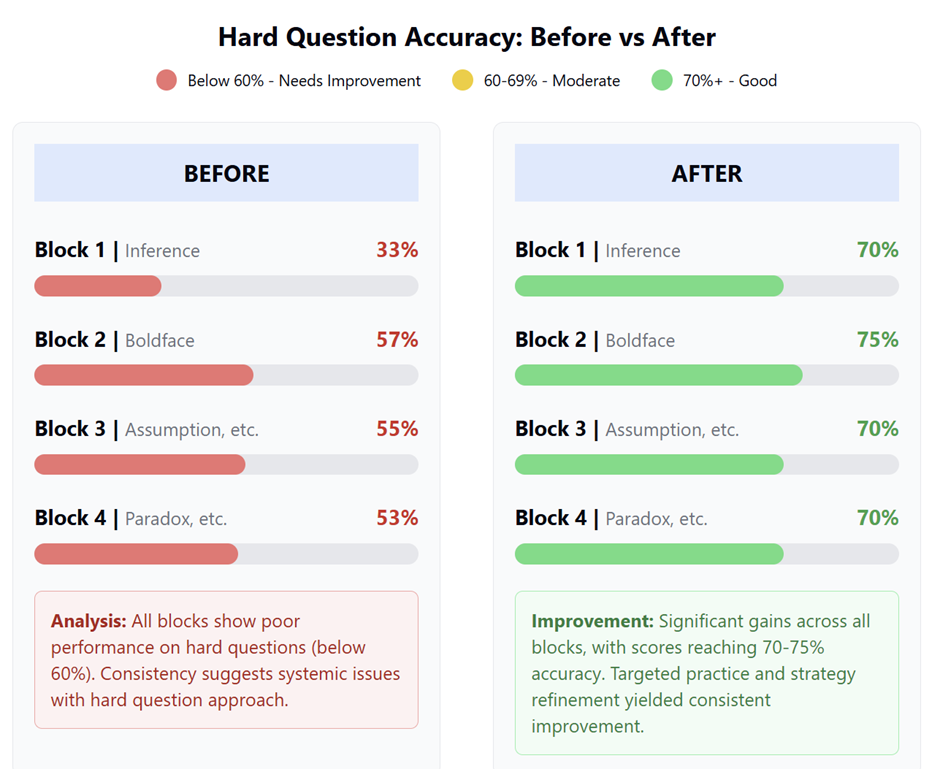
Remember, breaking behavioral patterns requires conscious effort. You'll need to slow down initially to build better habits, but this investment pays significant dividends in your eventual speed and accuracy.
Targeted Improvement for Specific Question Types:
If your diagnosis reveals that you struggle primarily with specific CR blocks, your first step is to precisely identify which question types are causing the most difficulty.
Start by examining your accuracy data across the four CR blocks. Look for significant disparities in your performance. When you're consistently scoring 70-75% on some blocks but only 50-60% on others, you're dealing with specific gaps rather than general application issues. Here in this case, we can see that while the accuracy across Blocks 3 and 4 is great (>70%), the accuracy across Blocks 1 & 2 is below 60%:
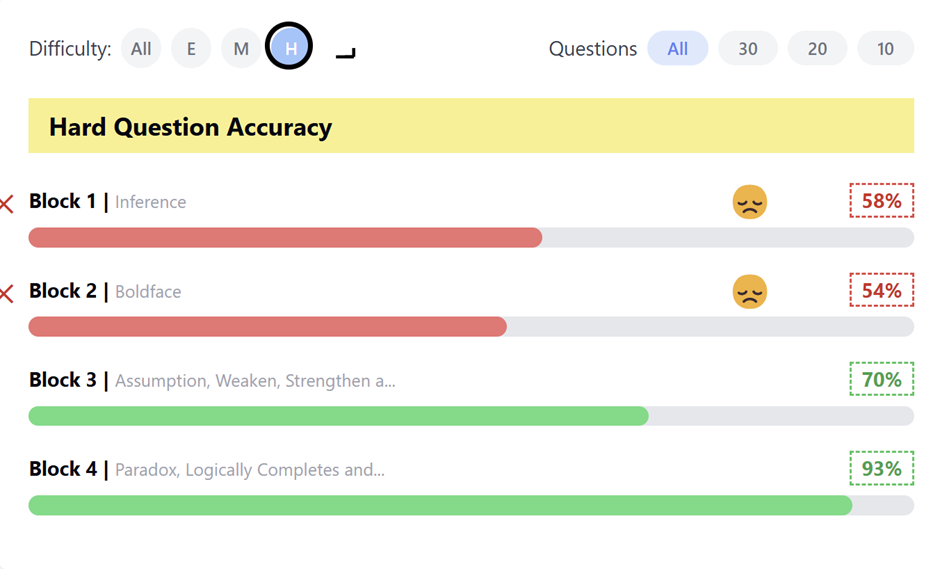
When analyzing your error log for these underperforming blocks, ask yourself:
Once you've identified your specific block weaknesses, your improvement plan should address the gaps directly – these could be concept-level gaps or process-level gaps. The error log analysis should help you identify these.
Sample Plan:
Here is a sample plan used by one of our students that helped fix their weakness in specific blocks and improve to 90th percentile in CR:

For detailed plan click here - https://www.dropbox.com/scl/fi/46irjtd0jn5fkkxodizr6/CR-Improvement-Plan-Block-1-2_e-GMAT.xlsx?rlkey=61yoh6fcveil2oucrbyknvmwu&st=45kcahja&dl=0
Results:
We can see the results of the improvement plan here:
Improvement in Inference Block:
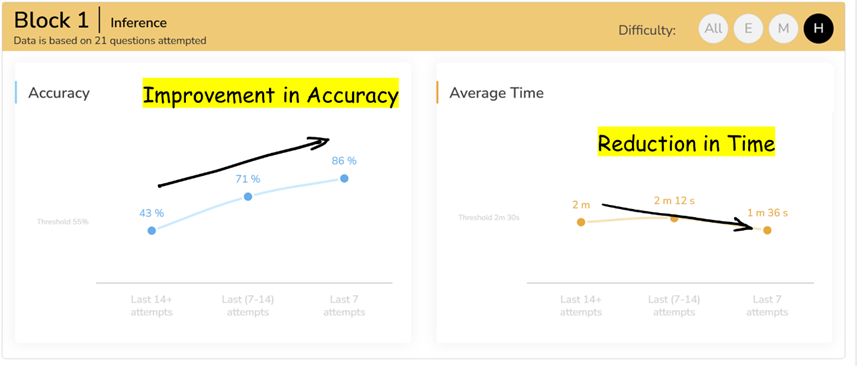
Improvement in Boldface Block:
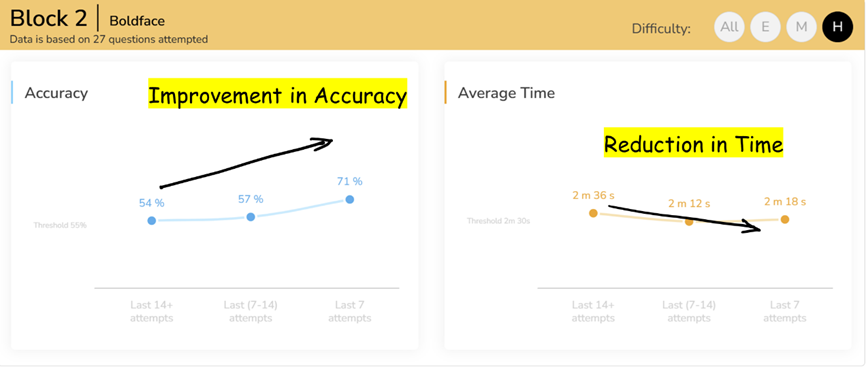
Remember, for this type of improvement, quality trumps quantity. Thoroughly analyzing 10-15 questions in your weak area will yield better results than rushing through 100+ questions without proper reflection.
To wrap it up:
Most people who reach the 70th percentile in CR have the ability to reach the 90th percentile. What might seem like an insurmountable barrier is actually a challenge that can be systematically overcome.
What's needed is a structured approach and a reasonable time commitment. The improvement process typically requires just 1-2 weeks of focused improvement, depending on the number of blocks that need improvement. This relatively small investment of time yields tremendous returns, potentially transforming your application profile and expanding your opportunities.
Remember that this journey isn't about practicing more questions - it's about practicing differently. By systematically identifying your specific weaknesses and applying targeted strategies, you can make the leap that many GMAT test-takers find elusive.
The path from the 70th to the 90th percentile is challenging but absolutely achievable. With the diagnostic approach and improvement frameworks outlined in this article, you have everything you need to break through this critical barrier and achieve the CR score you're capable of reaching.[/align]

GMAT-Club-Forum-ogl0kedn.png [ 55.18 KiB | Viewed 822 times ]

GMAT-Club-Forum-ocw87t12.png [ 138.48 KiB | Viewed 852 times ]

GMAT-Club-Forum-u5wjm5t2.png [ 74.93 KiB | Viewed 838 times ]

GMAT-Club-Forum-uw0mrjho.png [ 76.02 KiB | Viewed 830 times ]

GMAT-Club-Forum-fgdd3f6n.png [ 231.28 KiB | Viewed 848 times ]

GMAT-Club-Forum-5horwq3s.png [ 196.85 KiB | Viewed 858 times ]

GMAT-Club-Forum-bkb16kep.png [ 77.31 KiB | Viewed 843 times ]

GMAT-Club-Forum-alp1wiv9.png [ 50.03 KiB | Viewed 818 times ]

GMAT-Club-Forum-8ob5vi2v.png [ 51.64 KiB | Viewed 814 times ]
The critical thing that most of us are unaware of is - the difference between the 70th and 90th percentile in Critical Reasoning isn't about knowledge—it's about execution. Having helped over 300 students break through this exact plateau, I can confidently state that if you've reached the 70th percentile, you already possess what it takes to reach the 90th.
This distinction isn't merely academic—the jump from 70th to 90th percentile in verbal sections can make a significant difference in your overall GMAT score. That's often the difference between a 645 and a 705, potentially transforming your application from borderline to competitive at top business schools.
In this article, I'll reveal the systematic approach that has consistently helped students make this leap, without requiring endless practice or magical new techniques. You'll learn precisely how to identify what's holding you back and implement targeted strategies that yield measurable results.
Understanding the 70th Percentile Position?
What does it actually mean to be at the 70th percentile in Critical Reasoning? Many test-takers at this level don't fully understand their position—they just know they're not where they want to be.
If you're consistently scoring around the 70th percentile in CR, you have a solid foundation. You have a solid grasp of core CR concepts across most question types. You follow a structured process when approaching questions. You can identify argument components and understand basic logical relationships.
In other words, the challenge isn't your knowledge base; it's the specific weaknesses or bad habits that prevent you from consistently applying this knowledge to the most challenging questions.
These weaknesses often manifest in various ways. You might notice inconsistent performance on difficult questions, or find that time pressure particularly affects your accuracy on certain question types. Perhaps you frequently end up confused between two answer choices, or struggle to adapt when questions become more nuanced.
What makes the 70th percentile position particularly frustrating is that you're likely getting most straightforward and medium-difficulty questions correct but struggling with consistency on the hardest ones. This pattern is exactly what prevents the jump to 90th percentile performance.
Understanding this position is crucial because it helps you recognize that your improvement strategy needs to be precise and targeted. You don't need to relearn the basics—you need to refine your approach for those specific situations where your performance breaks down.
Creating Your Improvement Plan for Widespread Weaknesses
Before you can break through to the 90th percentile, you need to accurately diagnose what's holding you back. At e-GMAT, we divide Critical Reasoning into 4 distinct blocks to help pinpoint exactly where students struggle.
Block 1 - Inference
Block 2 - Boldface
Block 3 - Assumption, Weaken, Strengthen, and Evaluate
Block 4 - Paradox, Logically Completes and Misc.
There are two primary categories of weaknesses that typically affect students at the 70th percentile:
What are these, and how do you determine which category applies to you? The answer lies in your performance data.
Start by analyzing your accuracy across different question types and difficulty levels. Look specifically at your performance on difficult questions in each CR block.
Widespread application weaknesses:
These affect your performance across all CR question types. If your accuracy is consistently lower on difficult questions, regardless of the question type, you likely have an application issue that stems from either process execution or underlying habits.
In this image, we can see that across the blocks, the accuracy is below 60%, so it needs improvement across the blocks.
Here you'll often notice that your process breaks down at the same point across different question types, which boils down to bad habits – maybe you are not visualizing the argument well or you are rushing through the answer choice analysis.
Specific weaknesses in particular blocks:
In this case, you might perform well in most areas but struggle significantly with specific question types (such as Inference or Boldface questions). Your accuracy data would show a clear discrepancy between different CR blocks.
In this image, we can see that while the accuracy for Blocks 2 and 3 is great (above 70%), the accuracy for Blocks 1 and 2 is below 50% - so we need to improve the accuracy for Blocks 1 & 4 and maintain the accuracy in Blocks 2 & 3.
For specific weaknesses, you'll see that certain question types consistently trigger the same errors.
Taking the time to perform this detailed diagnosis is crucial. Without it, you risk spending dozens of hours practicing without addressing the real issues holding you back.
Creating Your Improvement Plan for Widespread Weaknesses:
If your diagnosis reveals that you have widespread application weaknesses across all CR question types, your first step is to identify the specific habits or behaviors causing this pattern.
Start by examining your error log data. Look for questions where you were confident in your answer but still got it wrong. These moments reveal the most about your process weaknesses. When reviewing these questions, ask yourself:
- Am I consistently visualizing correctly? This is the most common reason for people who have widespread weakness, since visualization cuts across CR.
- Do I rush through pre-thinking or skip it entirely on difficult questions?
- Do I eliminate answer choices based on gut feeling rather than concrete reasoning?
- Do I second-guess myself and change correct answers to incorrect ones?
Once you've identified your specific weakness, your improvement plan should focus on reinforcing the correct behaviors through deliberate practice. This isn't about solving more questions—it's about solving questions differently.
Create sets of 7-10 hard questions and do focused practice to fix this particular step.
Sample Plan:
Here is a sample plan used by one of our students that helped them improve to the 90th percentile:
For detailed plan click here - https://www.dropbox.com/scl/fi/46irjtd0jn5fkkxodizr6/CR-Improvement-Plan-Block-1-2_e-GMAT.xlsx?rlkey=61yoh6fcveil2oucrbyknvmwu&st=nzcqvx42&dl=0
Results:
After following the plan, we can see that the hard accuracy across all blocks improved to 70 %+:
Remember, breaking behavioral patterns requires conscious effort. You'll need to slow down initially to build better habits, but this investment pays significant dividends in your eventual speed and accuracy.
Targeted Improvement for Specific Question Types:
If your diagnosis reveals that you struggle primarily with specific CR blocks, your first step is to precisely identify which question types are causing the most difficulty.
Start by examining your accuracy data across the four CR blocks. Look for significant disparities in your performance. When you're consistently scoring 70-75% on some blocks but only 50-60% on others, you're dealing with specific gaps rather than general application issues. Here in this case, we can see that while the accuracy across Blocks 3 and 4 is great (>70%), the accuracy across Blocks 1 & 2 is below 60%:
When analyzing your error log for these underperforming blocks, ask yourself:
- Do I understand what this question type is actually testing?
- Am I approaching these questions with the right methodology?
- Is my timing significantly longer on these questions compared to others?
Once you've identified your specific block weaknesses, your improvement plan should address the gaps directly – these could be concept-level gaps or process-level gaps. The error log analysis should help you identify these.
Sample Plan:
Here is a sample plan used by one of our students that helped fix their weakness in specific blocks and improve to 90th percentile in CR:

For detailed plan click here - https://www.dropbox.com/scl/fi/46irjtd0jn5fkkxodizr6/CR-Improvement-Plan-Block-1-2_e-GMAT.xlsx?rlkey=61yoh6fcveil2oucrbyknvmwu&st=45kcahja&dl=0
Results:
We can see the results of the improvement plan here:
Improvement in Inference Block:
Improvement in Boldface Block:
Remember, for this type of improvement, quality trumps quantity. Thoroughly analyzing 10-15 questions in your weak area will yield better results than rushing through 100+ questions without proper reflection.
To wrap it up:
Most people who reach the 70th percentile in CR have the ability to reach the 90th percentile. What might seem like an insurmountable barrier is actually a challenge that can be systematically overcome.
What's needed is a structured approach and a reasonable time commitment. The improvement process typically requires just 1-2 weeks of focused improvement, depending on the number of blocks that need improvement. This relatively small investment of time yields tremendous returns, potentially transforming your application profile and expanding your opportunities.
Remember that this journey isn't about practicing more questions - it's about practicing differently. By systematically identifying your specific weaknesses and applying targeted strategies, you can make the leap that many GMAT test-takers find elusive.
The path from the 70th to the 90th percentile is challenging but absolutely achievable. With the diagnostic approach and improvement frameworks outlined in this article, you have everything you need to break through this critical barrier and achieve the CR score you're capable of reaching.[/align]
Attachment:
GMAT-Club-Forum-ogl0kedn.png [ 55.18 KiB | Viewed 822 times ]
Attachment:
GMAT-Club-Forum-ocw87t12.png [ 138.48 KiB | Viewed 852 times ]
Attachment:
GMAT-Club-Forum-u5wjm5t2.png [ 74.93 KiB | Viewed 838 times ]
Attachment:
GMAT-Club-Forum-uw0mrjho.png [ 76.02 KiB | Viewed 830 times ]
Attachment:
GMAT-Club-Forum-fgdd3f6n.png [ 231.28 KiB | Viewed 848 times ]
Attachment:
GMAT-Club-Forum-5horwq3s.png [ 196.85 KiB | Viewed 858 times ]
Attachment:
GMAT-Club-Forum-bkb16kep.png [ 77.31 KiB | Viewed 843 times ]
Attachment:
GMAT-Club-Forum-alp1wiv9.png [ 50.03 KiB | Viewed 818 times ]
Attachment:
GMAT-Club-Forum-8ob5vi2v.png [ 51.64 KiB | Viewed 814 times ]
Moderator:













